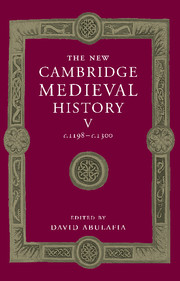Book contents
- Frontmatter
- Introduction
- Part I Common Themes
- 1 Social change in the thirteenth century
- (a) Nobles and knights
- (b) Urban society
- (c) Rural society
- 2 Commerce and communications
- 3 The vernacular
- 4 Art and architecture
- Part II The Church in the Thirteenth Century
- Part III The Western Kingdoms
- Part IV Italy
- Part V The Mediterranean Frontiers
- Part VI The Northern and Eastern Frontiers
- Appendix Genealogical tables
- Primary sources and secondary works arranged by chapter
- Index
- Plate section
- Map 1 Europe in the thirteenth century
- Map 3 France, c. 1260
- Map 5 Germany and the western empire
- Map 6 Genoa, Venice and the Mediterranean
- Map 8 The Latin empire of Constantinople and its neighbours
- Map 10 Aragon and Anjouin the Mediterranean">
- References
(a) - Nobles and knights
from 1 - Social change in the thirteenth century
Published online by Cambridge University Press: 28 March 2008
- Frontmatter
- Introduction
- Part I Common Themes
- 1 Social change in the thirteenth century
- (a) Nobles and knights
- (b) Urban society
- (c) Rural society
- 2 Commerce and communications
- 3 The vernacular
- 4 Art and architecture
- Part II The Church in the Thirteenth Century
- Part III The Western Kingdoms
- Part IV Italy
- Part V The Mediterranean Frontiers
- Part VI The Northern and Eastern Frontiers
- Appendix Genealogical tables
- Primary sources and secondary works arranged by chapter
- Index
- Plate section
- Map 1 Europe in the thirteenth century
- Map 3 France, c. 1260
- Map 5 Germany and the western empire
- Map 6 Genoa, Venice and the Mediterranean
- Map 8 The Latin empire of Constantinople and its neighbours
- Map 10 Aragon and Anjouin the Mediterranean">
- References
Summary
THE thirteenth century was an era of growing population, extensive land clearance, expanding towns and rapid social mobility. Governments grew more powerful and legal systems more complex. Distinctions of legal and social rank also became more elaborate. All these developments affected the aristocracy of thirteenth-century Europe, but none will serve to define the aristocracy itself as a group within society. Rather, the aristocracy of thirteenth-century Europe defined itself by its self-conscious adherence to a European-wide set of common cultural values and assumptions embodied in the cult of chivalric knighthood. Before we discuss how the aristocracy changed, we must first know who they were. It is with chivalry, therefore, that we must begin.
By the end of the twelfth century, the ideology of chevalerie had gained wide-spread acceptance among the mounted, heavily armoured warriors of western Europe. Contemporaries were increasingly aware that together these chevaliers could be conceived of as constituting a distinctive order within society. Like the other orders of late twelfth-century society, this ordo militaris comprised a very wide range of social ranks, from kings and emperors at the top, down to the landless warriors who in turn shaded off into the ranks of the wealthier peasantry. Chivalric ideology did not originate with the great lords, and in the empire particularly they were latecomers to it. But by the last decades of the twelfth century it was these great lords who, through their patronage of tournaments, heraldry and literature, fostered a notion of chevalerie as a social order which bound together men of such otherwise disparate status in life, and who, by identifying themselves with it, identified chevalerie with true noblesse. Not all the men called milites in Latin sources were noble in the year 1200, and not all nobles would have been flattered to be called milites or even chevaliers.
Keywords
- Type
- Chapter
- Information
- The New Cambridge Medieval History , pp. 11 - 25Publisher: Cambridge University PressPrint publication year: 1999
References
- 1
- Cited by



